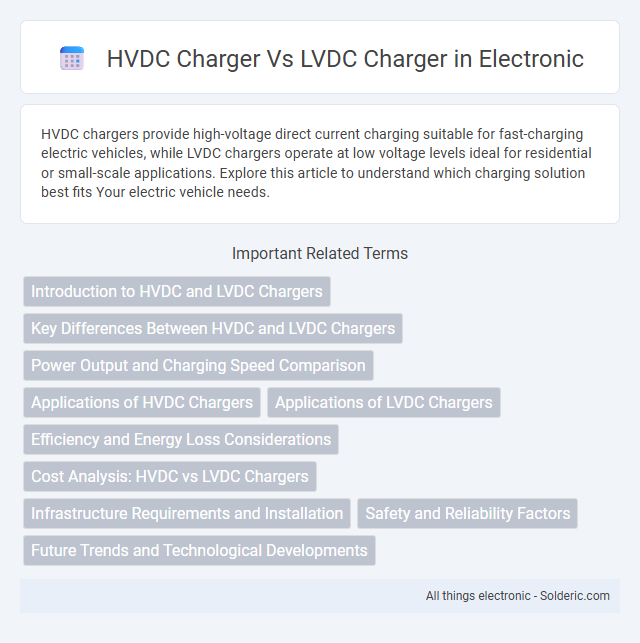HVDC chargers provide high-voltage direct current charging suitable for fast-charging electric vehicles, while LVDC chargers operate at low voltage levels ideal for residential or small-scale applications. Explore this article to understand which charging solution best fits Your electric vehicle needs.
Comparison Table
| Feature | HVDC Charger (High Voltage DC) | LVDC Charger (Low Voltage DC) |
|---|---|---|
| Voltage Level | Typically 400V to 1000V+ | Typically below 60V |
| Charging Speed | Fast charging (up to 350 kW or more) | Slower charging (usually under 10 kW) |
| Use Case | Electric vehicles, long-distance travel, fast charge stations | Small EVs, home chargers, low-power applications |
| Efficiency | High efficiency due to reduced losses at high voltage | Lower efficiency for long-distance power transfer |
| Safety | Requires strict safety protocols due to high voltage risks | Lower voltage, safer for residential use |
| Infrastructure Cost | Higher installation and equipment cost | Lower cost, simpler infrastructure |
| Applications | Commercial charging stations, public fast-charge networks | Residential, workplace charging, light electric vehicles |
Introduction to HVDC and LVDC Chargers
HVDC (High Voltage Direct Current) chargers enable rapid and efficient charging by delivering high voltage power directly to electric vehicles, reducing charging time significantly compared to traditional methods. LVDC (Low Voltage Direct Current) chargers operate at lower voltage levels, suitable for slower charging applications and smaller electric vehicles, providing safer and more cost-effective solutions. The choice between HVDC and LVDC chargers depends on charging speed requirements, vehicle battery specifications, and infrastructure capabilities.
Key Differences Between HVDC and LVDC Chargers
HVDC chargers operate at high voltage levels, typically above 1000V, enabling faster charging speeds and greater power efficiency for electric vehicles, while LVDC chargers function at lower voltages below 1000V, offering safer, more compact designs suitable for residential or low-power applications. HVDC systems require specialized insulation and cooling technologies to handle higher voltages and currents, whereas LVDC chargers rely on simpler architectures with less complex thermal management. Understanding these key differences helps you select the appropriate charger based on your vehicle's voltage specifications, charging speed demands, and installation environment.
Power Output and Charging Speed Comparison
HVDC chargers typically deliver power outputs ranging from 150 kW to over 350 kW, enabling ultra-fast charging speeds that can replenish an electric vehicle battery to 80% in 20-30 minutes. LVDC chargers, usually rated between 3.3 kW to 22 kW, offer slower charging speeds suited for residential or workplace settings, requiring several hours for a full charge. The higher power capacity of HVDC chargers results in significantly reduced charging times, making them ideal for long-distance travel and commercial applications.
Applications of HVDC Chargers
HVDC chargers are predominantly used in high-power electric vehicle fast-charging stations, industrial applications, and long-distance energy transmission due to their efficiency in minimizing energy loss and supporting higher voltage levels. Your electric fleet benefits from HVDC chargers through rapid charging capabilities, reducing downtime and increasing operational productivity. These chargers excel in grid stabilization and integration of renewable energy sources, making them essential in smart grid infrastructures.
Applications of LVDC Chargers
LVDC chargers are ideal for residential solar energy systems, small-scale off-grid applications, and portable electronic device charging due to their lower voltage range and enhanced safety features. They efficiently support low-voltage DC loads such as LED lighting, communication equipment, and battery storage systems in remote or mobile settings. Your choice of an LVDC charger provides reliable, cost-effective power management for low-voltage applications where HVDC solutions would be impractical or unnecessarily complex.
Efficiency and Energy Loss Considerations
HVDC chargers offer higher efficiency compared to LVDC chargers by minimizing energy losses during long-distance power transmission thanks to reduced resistive heating and improved voltage regulation. LVDC chargers tend to experience greater energy loss due to higher current flow and voltage drop over cables, making them less efficient in large-scale or high-power applications. Understanding these efficiency differences can help you choose the most energy-saving option for your charging infrastructure.
Cost Analysis: HVDC vs LVDC Chargers
HVDC chargers typically have higher initial costs due to advanced power electronics and insulation requirements but offer greater efficiency and faster charging speeds, potentially reducing long-term operational expenses. LVDC chargers are generally more affordable upfront and easier to install but may incur higher energy losses and slower charging times, impacting overall cost-effectiveness. Your choice depends on balancing upfront investment against efficiency and charging performance needs.
Infrastructure Requirements and Installation
HVDC chargers require robust infrastructure with higher voltage equipment, specialized cables, and advanced cooling systems to handle efficient long-distance power transmission. LVDC chargers demand less complex installations, utilizing standard wiring and simpler components suitable for residential or small commercial setups. The installation cost and technical expertise for HVDC systems are significantly higher due to stringent safety and maintenance standards compared to LVDC systems.
Safety and Reliability Factors
HVDC chargers offer higher safety with built-in advanced insulation and fault detection systems that minimize electrical hazards during high-voltage transmission. LVDC chargers provide enhanced reliability through lower voltage levels, reducing the risk of electrical arcing and making them easier to maintain and troubleshoot. Your choice between HVDC and LVDC chargers should balance the required efficiency with safety protocols tailored to your specific charging infrastructure.
Future Trends and Technological Developments
HVDC chargers are poised to dominate future electric vehicle infrastructure due to their higher power transfer efficiency and ability to support ultra-fast charging speeds exceeding 350 kW, facilitating decreased charging times and enhanced grid integration. Advancements in wide-bandgap semiconductor materials like silicon carbide (SiC) and gallium nitride (GaN) are driving improvements in HVDC charger power density and thermal management, enabling more compact and reliable designs. LVDC chargers, while more suited for low-power residential applications, are evolving with integrated smart grid features and bidirectional power flow capabilities to support energy storage and demand response, but their scalability remains limited compared to HVDC systems.
HVDC charger vs LVDC charger Infographic

 solderic.com
solderic.com